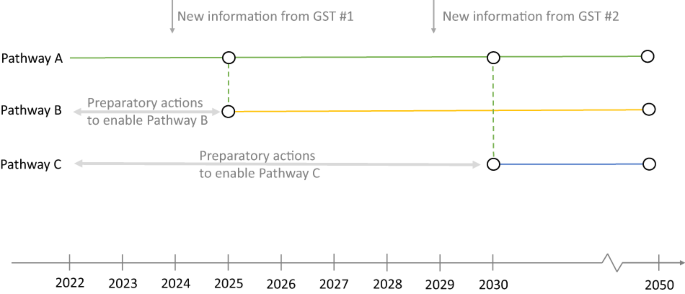Getting to 1.5C might need some course adjustments
Published in Earth & Environment
Getting to net zero across the world, to try to limit global warming to 1.5oC, won't be easy. The sheer number of changes that need to happen across so many different industries, infrastructures and communities is daunting. It feels, at this late stage of the game, when the carbon budget to keep in line with the goals of the Paris Agreement has almost disappeared, as though we have to throw everything at it, and hope that everything goes right.
But even at this point, a sensible risk management strategy wouldn't go amiss. Specifically, we should put in place a set of considerations and measures around what to do if things don't work out quite as hoped on the pathway to net zero.
What might those mis-steps, or misfortunes, entail? It's these questions that our team, spanning the UK Met Office and Imperial College London, asked ourselves back in 2021, when thinking about this "decisive decade" of climate action. We reflected on the fact that the carbon budget for 1.5oC remains uncertain, owing to a range of estimates of the warming caused by each further tonne of CO2 emissions. We were all-too-aware of the hopes vested in a vast scale up of wind and solar, whilst also realising that many past technological transitions have gone slower than hoped. We were seeing increasing evidence of forest dieback and dry-out. This is particularly concerning when considering that the expected absorption of atmospheric CO2 into the land and forests over the rest of this century is - in many future scenarios - expected to be a significant source of "negative emissions", offsetting potentially over a hundred billion tonnes of future CO2 from the continued burning of fossil fuels. What might we do if this sink turns into a source, as forests and soil release carbon in hotter, dryer conditions in the years to come?
We dived into these questions by designing a set of future emissions reduction pathways that not only attempted to keep temperatures from exceeding 1.5oC, but that could potentially be changed if - at different points in the future - it became clear that not all was going according to plan. Such "dynamic adaptive policy pathways" (DAPP) thinking is becoming increasingly attractive for all sorts of policy design. For example, in New Zealand, there is a commitment in water infrastructure planning to undertaking a dynamic planning process, with the option space kept open to adjust course in light of unforeseen circumstances. This is highly advisable given that it's virtually impossible to know how key factors, like flood frequency or extent, will manifest.
We set up a model simulation process to explore how a least cost pathway to 1.5oC, as calculated using an integrated assessment model, would change if 'shocked' in the future by new information, such as lower maximum-allowed growth rates of solar and wind, a suddenly-smaller carbon budget, a reverse of land from sink to source, and less carbon capture potential. All of these seem salient and possible, and could be hammer blows to our pathway to 1.5oC. It isn't actually difficult to implement such occurrences in our model, TIAM (the TIMES Integrated Assessment Model), as - like many such models which simulate the future evolution of the energy (and often land) systems across the world to meet given emissions or temperature goals - it's possible to "pause" the model runs at particular future dates. Assumptions fed into the model, around technology maximum growth rates, availability of technologies, and allowed emissions budgets, can then be changed from those dates onwards. This enables an exploration of how an initially optimal (in terms of cost) modelled pathway changes onto a new optimal pathway with respect to the updated conditions that are fed into the model. Linking the model (which, in our setup, focuses only on CO2 emissions) to a separate model that provides estimates of non-CO2, and then to a simple climate model that converts the greenhouse gas emissions into ranges of temperature increase (the range reflecting probabilistic uncertainty around the emissions to temperature conversion) gives us an understanding of how the overall temperature evolves along each pathway.
We found that our modelling set up indicated, unsurprisingly, that smaller carbon budgets and loss of reliance of emissions removals from the land meant much faster deployment of man-made carbon removal technologies, greater energy demand reductions across our industrial, transport and building sectors, and greater rates of electrification of energy in these sectors. With less wind and solar, we only had gas available in the short term, but hydro, geothermal, nuclear and even ocean-based energy had to step up to fill in the gaps in the longer term, along with a greater role for man-made emissions removals later in the century. Unsurprisingly, these changes bring greater costs. Even our simulation of significant behavioural shifts to further lower energy demand couldn't bring these costs back to the levels in our base case scenario in which nothing went awry.
To some extent these results are unsurprising. Higher costs, more reliance on technological carbon removal, and a role for other zero-carbon technologies to solar and wind would all be expected, as would the dampening benefits of energy saving measures. But the magnitude of changes is instructive, as is the indication that -even though only in “model-land” - we could still adjust our course to keep the 1.5oC goal alive. This suggests we need not just a commitment to rapid emissions reduction, but a prudent risk management strategy to prepare and prime alternative technological and behavioural pathways if our favoured one under-delivers. Of course, such risk management actions (think of them as partial insurance against under-performance, or failure, of Plan A) will add additional costs to society in the near-term. But who's to say there wouldn't be benefits from such additional research, development and demonstration of a great range of technologies, resulting from general learning that might transcend technologies and sectors? We certainly see broad evidence for such "positive externalities" across technology development, with “clean” tech somewhat more potent a source of such effects than “dirty” tech.
And if we are serious about the goal of 1.5oC, it might just be sensible to not just throw everything at Plan A, but also to prepare a Plan B (and maybe C) as well! We are talking about the biophysical safety of our entire species (not to mention countless others), after all.
Follow the Topic
-
Nature Communications

An open access, multidisciplinary journal dedicated to publishing high-quality research in all areas of the biological, health, physical, chemical and Earth sciences.
Related Collections
With Collections, you can get published faster and increase your visibility.
Women's Health
Publishing Model: Hybrid
Deadline: Ongoing
Advances in neurodegenerative diseases
Publishing Model: Hybrid
Deadline: Dec 24, 2025






Please sign in or register for FREE
If you are a registered user on Research Communities by Springer Nature, please sign in